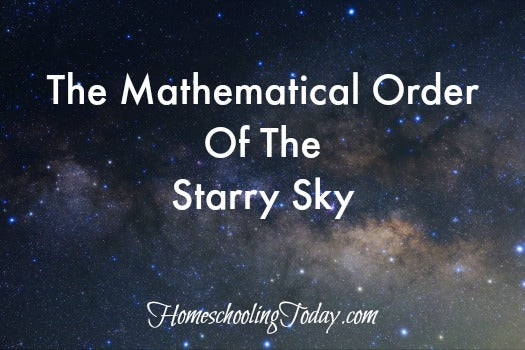The Mathematical Order of the Starry Sky

The heavens declare the glory of God; and the firmament sheweth his handywork.
—Psalm 19:1
Recently my pastor asked me, “How exactly do the heavens declare the glory of God?” After I pondered that question, I explained that the sky is the only aspect of creation that reveals a precise mathematical order.Mathematical Order Of Creation
Many mathematical examples exist in creation, from hexagonal snowflakes to the spiral of a snail shell. But hidden in the sky is a complete geometrical system that defines precise quantitative relationships, enabling practical measurements and yielding useful results. When the Bible was written, classical astronomy was the only exact science in practice, and astronomical study resulted in the modern science of physics, the basis of all our modern technology. Psalm 19 continues, “Day unto day uttereth speech, and night unto night sheweth knowledge. There is no speech nor language, where their voice is not heard.” This passage might puzzle some people who live in a modern American suburb and observe an unimpressive night sky spoiled by street lighting. But David, Israel’s king, spent most of his early life under pristine night skies as a shepherd and soldier. He could hear the inaudible “speech” of the heavens and understood the “knowledge” it showed in a manner nearly forgotten in our high-tech, contemporary world.Calculating The Firmament
Under a perfectly dark sky remote from city lights, all stars seem to be an equal distance away. Thus, the night sky appears to be a great dome of stars, an enormous celestial sphere, with the observer located at the center. We know today that this is an illusion and that the stars are virtually infinite in distance. However, the Hebrew word for “firmament” is raqia, which means expanse, an even better word to describe the vast distances to stars. Since the sky appears as a great sphere, we can actually treat it as a geometrical sphere and envision circles that lie along the surface of the celestial sphere. Traditional classical astronomy has historically defined a great number of celestial circles, including horizon, meridian, celestial equator, and ecliptic.
Like any other circle, we can divide each of these celestial circles into 360 degrees and measure angular distances between any two points in the sky. For instance, we can measure 90 degrees along the horizon from due north to due east and 180 degrees from north to south. Along the meridian, we can measure 90 degrees between the view sideways to the horizon and the view overhead to the zenith.
Since the sky appears as a great sphere, we can actually treat it as a geometrical sphere and envision circles that lie along the surface of the celestial sphere. Traditional classical astronomy has historically defined a great number of celestial circles, including horizon, meridian, celestial equator, and ecliptic.
Like any other circle, we can divide each of these celestial circles into 360 degrees and measure angular distances between any two points in the sky. For instance, we can measure 90 degrees along the horizon from due north to due east and 180 degrees from north to south. Along the meridian, we can measure 90 degrees between the view sideways to the horizon and the view overhead to the zenith.
 We can also envision that any two objects in the sky lie along a circle and measure the angle between them. For example, on a given night, the moon might be passing close to the bright planet Jupiter and be only two degrees apart. Imagine a line extending from your eye to the moon and another line extending from your eye to Jupiter. The lines will form an angle of two degrees. Measuring angular separations in this way is the typical manner of locating celestial objects in the sky.
Since we use angle measurement in the spherical sky, we can also apply standard techniques of geometry. This is the ancient science of spherical astronomy. The great Greek geometer Euclid wrote a treatise on spherical astronomy in about 300 BC, in addition to his better-known work on plane geometry, which still provides the basis for geometry textbooks today.
Angle measurement enables us to measure movements of celestial objects. We can measure that the sun moves 15 degrees across the sky every hour, from rising to setting. The moon moves about 13 degrees each day toward the east, as it waxes and wanes through its cycle of phases.
In addition to its daily motion from east to west, the sun also moves about one degree per day from west to east, so we can measure the annual cycle of the seasons. In this way, angle measurement is required for measuring time, the actual purpose for which the sun and moon were created: “And God said, Let there be lights in the firmament of the heaven to divide the day from the night; and let them be for signs, and for seasons, and for days, and years” (Genesis 1:14).
********************
Jay Ryan is the author of Signs & Seasons: Understanding the Elements of Classical Astronomy, a homeschool astronomy curriculum, and Moonfinder, a book for every member of the family to learn how to follow the monthly cycle of the moon's phases. Visit Ryan’s website at www.classicalastronomy.com.
We can also envision that any two objects in the sky lie along a circle and measure the angle between them. For example, on a given night, the moon might be passing close to the bright planet Jupiter and be only two degrees apart. Imagine a line extending from your eye to the moon and another line extending from your eye to Jupiter. The lines will form an angle of two degrees. Measuring angular separations in this way is the typical manner of locating celestial objects in the sky.
Since we use angle measurement in the spherical sky, we can also apply standard techniques of geometry. This is the ancient science of spherical astronomy. The great Greek geometer Euclid wrote a treatise on spherical astronomy in about 300 BC, in addition to his better-known work on plane geometry, which still provides the basis for geometry textbooks today.
Angle measurement enables us to measure movements of celestial objects. We can measure that the sun moves 15 degrees across the sky every hour, from rising to setting. The moon moves about 13 degrees each day toward the east, as it waxes and wanes through its cycle of phases.
In addition to its daily motion from east to west, the sun also moves about one degree per day from west to east, so we can measure the annual cycle of the seasons. In this way, angle measurement is required for measuring time, the actual purpose for which the sun and moon were created: “And God said, Let there be lights in the firmament of the heaven to divide the day from the night; and let them be for signs, and for seasons, and for days, and years” (Genesis 1:14).
********************
Jay Ryan is the author of Signs & Seasons: Understanding the Elements of Classical Astronomy, a homeschool astronomy curriculum, and Moonfinder, a book for every member of the family to learn how to follow the monthly cycle of the moon's phases. Visit Ryan’s website at www.classicalastronomy.com.
_________________________________________
Get quality articles like this one in each issue of Homeschooling Today Magazine.











